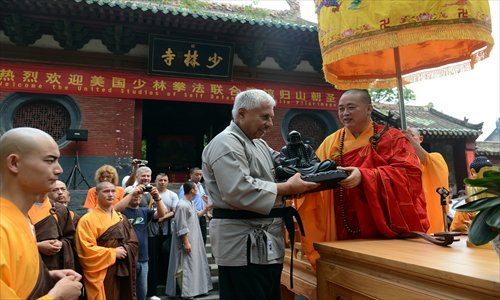Kung Fu revenue fighting
Global Times | 2013-7-22 0:13:01
By Zhang Xiaobo

The abbot of Shaolin Temple, Shi Yongxin (right), gives a statue of Buddha to a foreign student during a graduation ceremony at the Shaolin Temple at Mount Songshan in Dengfeng, Central China's Henan Province, on July 3. Photo: IC
The abbot of Shaolin Temple, Shi Yongxin (right), gives a statue of Buddha to a foreign student during a graduation ceremony at the Shaolin Temple at Mount Songshan in Dengfeng, Central China's Henan Province, on July 3. Photo: IC
Claims a hidden camera had been placed in the room of Shi Yongxin, the abbot of China's famous Shaolin Temple, have set the online community on fire in recent days, but that has proven to be almost insignificant when compared to the drawn-out commercial dispute that has enveloped the temple, resulting in men storming the ticket offices this month to seize control of sales.
A monk, who didn't reveal his name, denied the claims of hidden cameras on Wednesday. "Hidden cameras were never found in the temple. We have never heard of such a thing," he told the Global Times.
However, he did admit that the temple is not the quiet sanctuary many imagine and that a protracted struggle between the temple, the local government and corporate partners is damaging the sacred site, which is a massive source of revenue for the local government.
"Famous temples and governments always try to achieve mutually beneficial situations, however, it is not easy to find a fair way to distribute the profits between the two," Zhang Shangzheng, a tourism professor at Anhui University, told the Global Times Sunday.
Triangle of fury
The management committee of the Songshan Shaolin Temple Scenic Area and the Shaolin Temple made an agreement to divide the revenue from ticket sales, which states that 30 percent of the ticket revenue belongs to the temple, while the rest goes to the government.
However, the profits aren't always carved up this way. Abbot Shi Yongxin pointed out that the money received by the Shaolin Temple is less than the agreement stipulates, because the government controls all sales.
"We are not in charge of selling entrance tickets. So we are unlikely to know how many tickets are sold or what kind of tourists can enter for free. It all depends on the government," Shi Yongxin said in earlier media reports, adding that 70 percent of the income is set aside for temple construction, including the attached temples, 20 percent is to cover the costs of the monks' living expenses, and 10 percent is for charity.
"All that we can do to verify the amount of tickets sold is to count how many tourists enter the temple yard. That is the only way for us to know whether they are lying to us or not," the anonymous monk said.
The commercial situation faced by the temple was muddied by a 2009 agreement between a local government-owned tour company and the China Travel Service Hong Kong Ltd (CTS) to form a joint venture.
CTS is a powerful State-owned travel agency and owns a 51 percent share of the joint venture, which controls ticket sales for the scenic area.
According to the agreement, the ticket sales for the scenic area are regulated by the company. In return, CTS guaranteed at a press conference that it would invest up to 1 billion yuan into the construction of infrastructure at the scenic area over a three-year period.
Relationship goes sour
In October 2011, experts from the National Quality Ranking Committee of Tourist Attractions inspected the Songshan scenic area. They were dissatisfied with the conditions there and warned they would consider downgrading the rating of the area if it was not improved.
This was regarded as humiliating by the Dengfeng government, and it threatened the relationship between the CTS joint venture and the government, according to a Thursday report by the Dahe Daily.
The scenic area management committee also accused CTS of not actually planning to invest in the area as they had promised, and said the financial situation was getting worse.
"These situations involving debt often happen after the government relinquishes control over ticket sales," the monk told the Global Times.
"Some of the joint venture companies don't want to invest any more if they find the input-output ratio is too low, so they change their mind and choose to stop further investment. And that disappoints the government and ultimately the situation doesn't improve," Zhang told the Global Times.
The conflict finally exploded on July 1, when the scenic area management committee sent workers to forcibly seize control of the ticket office. The move succeeded on the first day, but was stopped by the upper administrative department on the second, according to the Dahe Daily.
"Usually, governments don't have enough resources to develop scenic areas, so they try to cooperate with some mature tour companies to obtain benefits and lower the risks. It seems like a wise choice, but they forget the potential danger when they choose a tour company at random," Zhang said.
Fighting for cash
The Shaolin Temple, which was established in 495 during the period of Northern Dynasties (386-581), is well known for the Shaolin style of kung fu. Its fame then shot to stratospheric levels after the 1982 kung fu classic Shaolin Temple.
"The Shaolin Temple saw its first batch of tourists in the early 1980s and the number rises every year," the monk told the Global Times. He said the temple now attracts over 1 million tourists per year, bringing in more than 100 million yuan ($16 million) annually in ticket sales.
Neither the temple nor the local government is willing to give up their slice of the profits.
"In some circumstances, it is hard for the temple to obtain the revenue even if they follow the government's calculations. The government of the Songshan scenic area owes the temple a large sum of ticket sales revenue. That is not surprising. It has been an open secret for years," a journalist from the Dahe Daily, who declined to be named, told the Global Times Thursday.
The large debt eventually resulted in wages being paid late for workers at the temple, which finally led to a protest.
"Many monks went to the Dengfeng government, which supervises the Songshan scenic area, to petition them in 2011. And it worked. They returned some of the money to us. But still, they have owed us over 30 million yuan since 2009," the monk told the Global Times, adding that the debt might have been caused by too much construction, evidenced by the many unfinished buildings around the site.
Liu Shaowei, a press official from the management committee, refused to comment on the matter to the Global Times.
"Temples rarely sue in these kinds of cases as most of them don't want to destroy the relationship with the local government," Zhang said.




 Reply With Quote
Reply With Quote







